tyre pressure MERCEDES-BENZ M-CLASS SUV 2011 Owner's Manual
[x] Cancel search | Manufacturer: MERCEDES-BENZ, Model Year: 2011, Model line: M-CLASS SUV, Model: MERCEDES-BENZ M-CLASS SUV 2011Pages: 389, PDF Size: 9.22 MB
Page 339 of 389
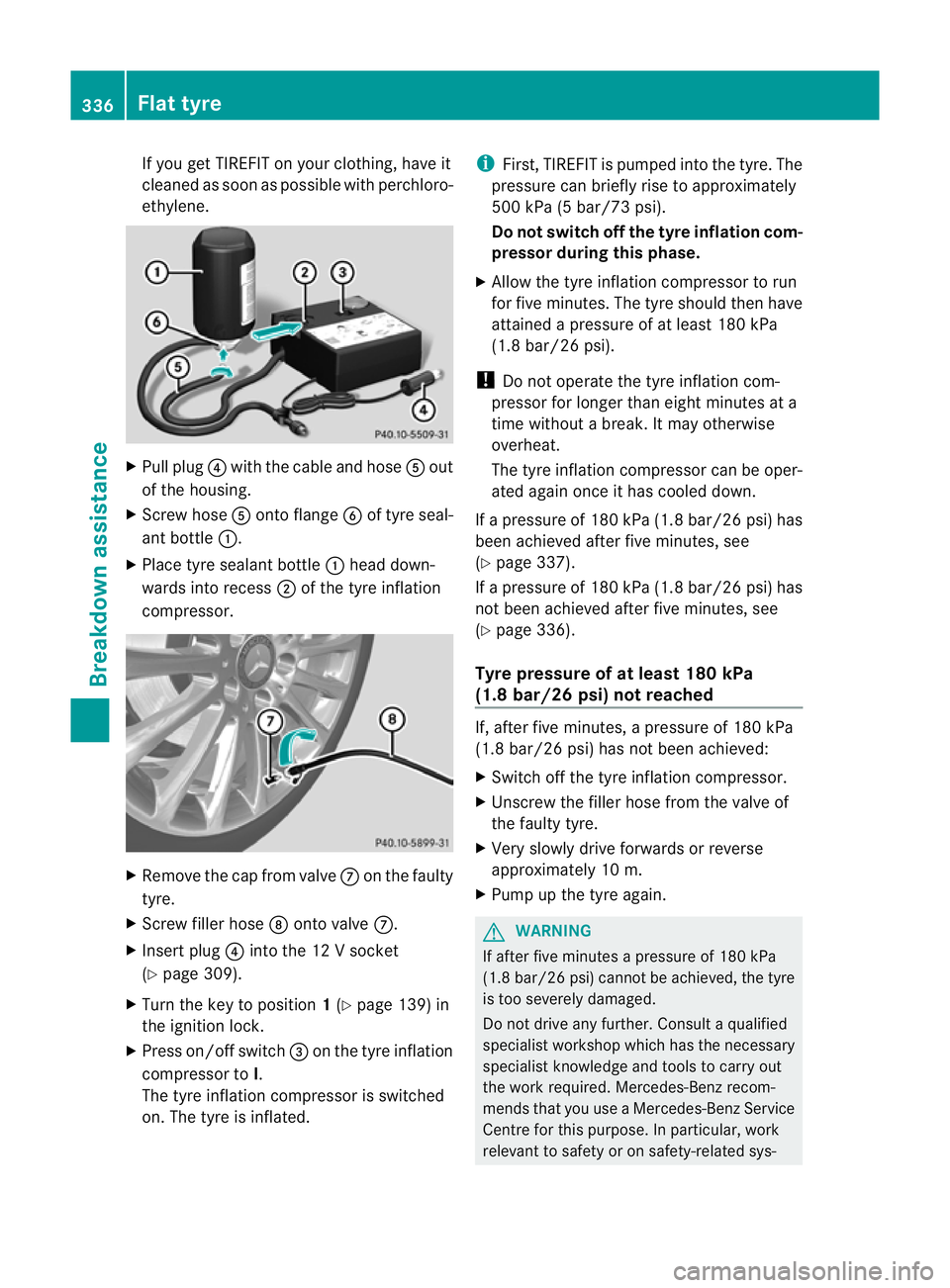
If yo
uget TIREFI Tonyour clothing, have it
cleaned as soo naspossible with perchloro-
ethylene. X
Pull plug ?with the cabl eand hose Aout
of the housing.
X Screw hose Aontoflange Bof tyre seal-
ant bottle :.
X Place tyre sealant bottle :head down-
wards int orecess ;of the tyr einflation
compressor. X
Remove the cap fro mvalve Con the faulty
tyre.
X Screw filler hose Dontovalve C.
X Insert plug ?into the 12 Vsocket
(Y page 309).
X Tur nthe key to position 1(Y page 139) in
the ignition lock.
X Press on/of fswitch =on the tyr einflation
compressor to I.
The tyr einflation compressor is switched
on. The tyre is inflated. i
First ,TIREFIT is pumpe dinto the tyre. The
pressure can briefly rise to approximately
500 kPa (5 bar/73 psi).
Do not switch off the tyr einflation com-
pressor du ring this phase.
X Allow the tyr einflation compresso rtor un
for five minutes. The tyre should then have
attained apressure of at leas t180 kPa
(1.8 bar/26 psi).
! Do not operat ethe tyr einflation com-
presso rfor longer than eight minutes at a
tim ew ithout abreak. It may otherwise
overheat.
Th et yre inflation compressor can be oper-
ated again once it has coole ddown.
If ap ressure of 180 kPa (1.8 bar/26 psi) has
been achieved afte rfive minutes, see
(Y page 337).
If ap ressure of 180 kPa (1.8 bar/26 psi) has
not been achieved afte rfive minutes, see
(Y page 336).
Tyr epressure of at least 180 kPa
(1.8 bar/26 psi) not reached If, after five minutes,
apressure of 180 kPa
(1.8 bar/26 psi) ha snot been achieved:
X Switch off the tyr einflation compresso r.
X Un screw the filler hose from the valv eof
the faulty tyre.
X Very slowly drive forwards or reverse
approximately 10 m.
X Pump up the tyre again. G
WARNING
If after five minutes apressure of 180 kPa
(1.8 bar/26 psi) cannot be achieved ,the tyre
is too severel ydamaged.
Do not drive any further. Consult aqualified
specialist workshop which has the necessary
specialist knowledge and tools to carry out
the work required. Mercedes-Benz recom-
mends that you use aMercedes-Ben zService
Centr efor this pur pose.Inp articular, work
relevant to safety or on safety-related sys- 336
Flat tyreBreakdown assistance
Page 340 of 389
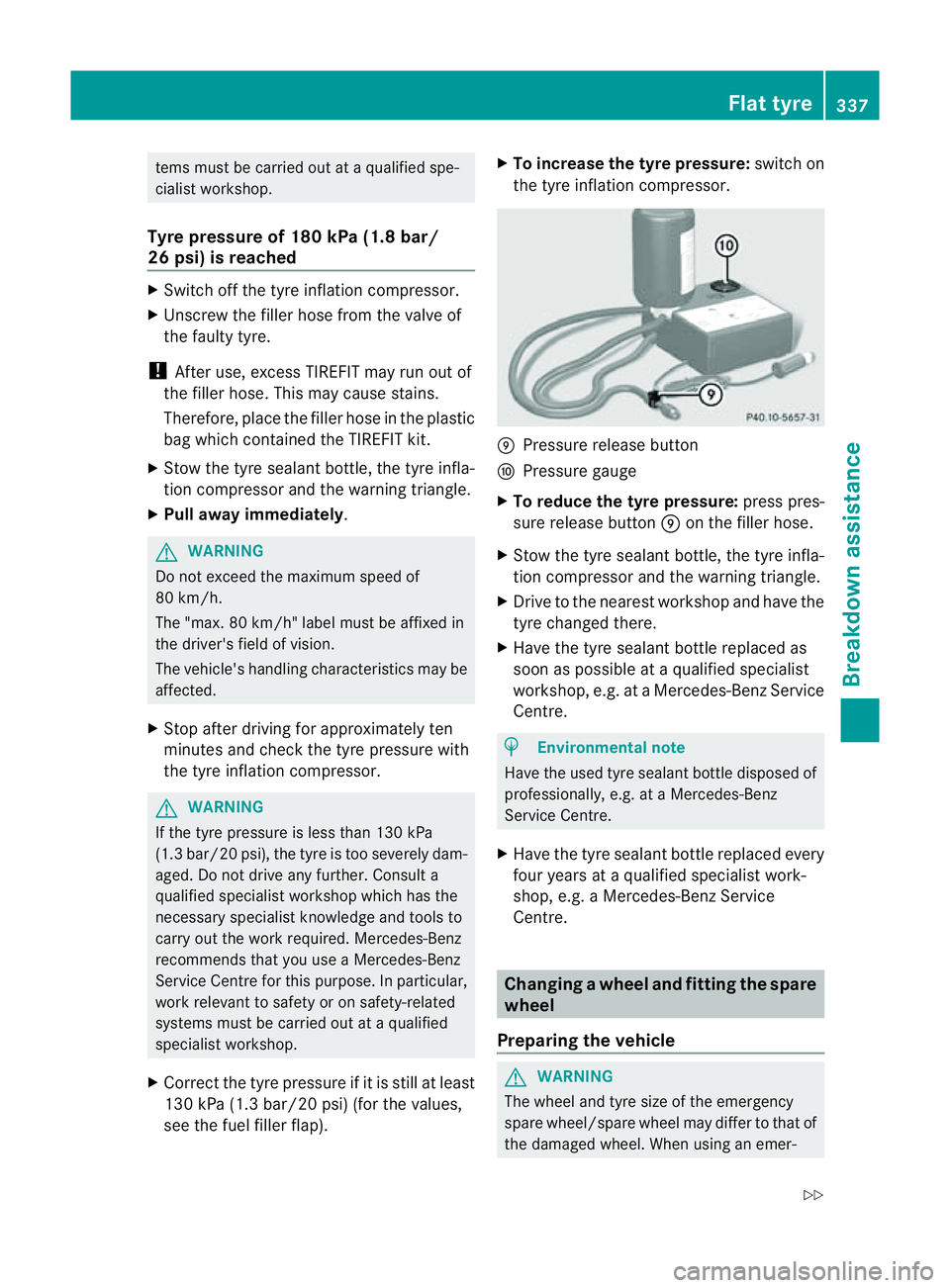
tems mus
tbec arrie dout at aquali fieds pe-
cialist workshop.
Ty re pressure of 180 kPa (1.8 bar/
26 psi) is reached X
Switch off the tyre inflation compressor.
X Unscrew the fille rhose from the valve of
the faulty tyre.
! Afteru se, excess TIREFIT ma yrun out of
the filler hose. This may cause stains.
Therefore, place the filler hos einthe plastic
bag whic hcontained the TIREFIT kit.
X Stow the tyr esealan tbottle, the tyr einfla-
tion compresso rand the warning triangle.
X Pull away immediately. G
WARNING
Do not exceed the maximum speed of
80 km/h.
The "max. 80 km/h" labe lmust be affixed in
the driver's field of vision.
The vehicle's handling characteristic smay be
affected.
X Stop after driving for approximately ten
minutes and check the tyre pressure with
the tyre inflation compressor. G
WARNING
If the tyre pressure is less than 130 kPa
(1.3 bar/2 0psi), the tyr eistoo severely dam-
aged. Do not driv eany further. Consult a
qualified specialis tworkshop which has the
necessary specialist knowledge and tools to
carry out the work required .Mercedes-Benz
recommends that you use aMercedes-Benz
Ser vice Centre for thi spurpose. In particular,
work relevant to safety or on safety-related
systems must be carried out at aqualified
specialist workshop.
X Correct the tyre pressure if it is still at least
130 kPa (1.3 bar/20 psi) (for the values,
see the fuel filler flap). X
To increase the tyr epressure: switchon
the tyre inflation compressor. E
Pressure releas ebutton
F Pressure gauge
X To reduce the tyr epressur e:press pres-
sure release button Eon the filler hose.
X Stow the tyr esealan tbottle, the tyr einfla-
tion compresso rand the warning triangle.
X Drive to the neares tworkshop and have the
tyr ec hange dthere.
X Hav ethe tyr esealan tbottle replaced as
soon as possible at aqualified specialist
workshop, e.g. at aMercedes-Benz Ser vice
Centre. H
Environmental note
Have the use dtyre sealant bottle dispose dof
professionally, e.g. at aMercedes-Benz
Ser vice Centre.
X Have the tyre sealant bottle replaced every
four years at aqualified specialist work-
shop, e.g. aMercedes-Benz Ser vice
Centre. Changing
awhee land fitting th espare
wheel
Preparing the vehicle G
WARNING
The wheel and tyre size of the emergency
spare wheel/s pare wh eelm ay differ to tha tof
the damaged wheel. Whe nusing an emer- Flat ty
re
337Breakd ownassistance
Z
Page 345 of 389
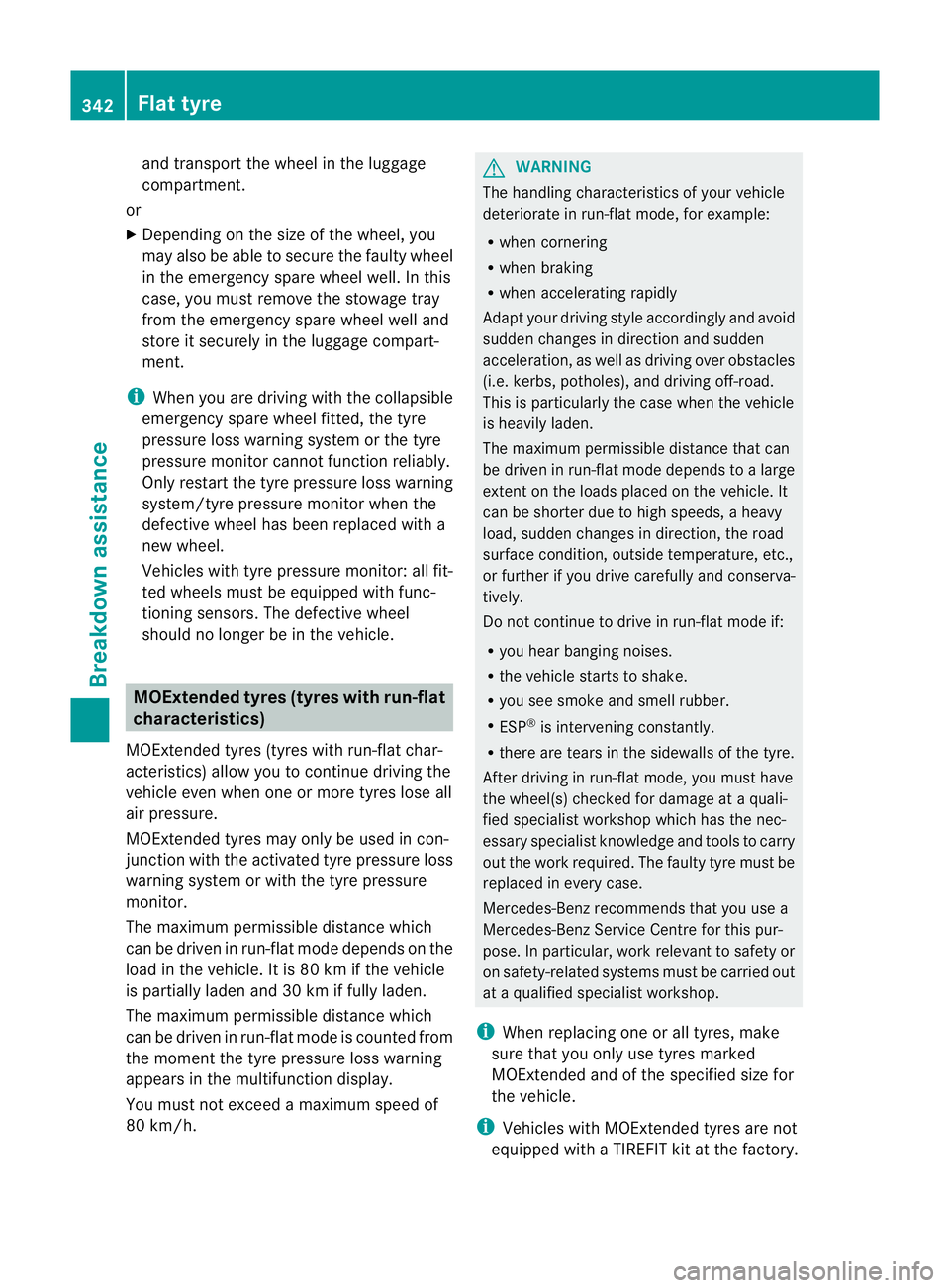
and transpor
tthe wheel in the luggage
compartment.
or
X Depending on the size of the wheel, you
ma yalso be able to secure the faulty wheel
in the emergenc yspare wheel well. In this
case, you must remove the stowage tray
from the emergency spare wheel well and
store it securely in the luggage compart-
ment.
i When you are driving with the collapsible
emergency spare wheel fitted, the tyre
pressur eloss warnin gsystem or the tyre
pressure monitor cannot function reliably.
Only restart the tyre pressure los swarning
system/tyre pressure monitor when the
defective wheel has been replaced with a
new wheel.
Vehicles with tyre pressure monitor: all fit-
ted wheels must be equipped with func-
tioning sensors. The defective wheel
should no longer be in the vehicle. MOExtended tyres (tyres with run-flat
characteristics)
MOExtended tyres (tyres with run-flat char-
acteristics) allow you to continue driving the
vehicle even when one or more tyres lose all
air pressure.
MOExtended tyres may only be used in con-
junction with the activated tyre pressure loss
warning system or with the tyre pressure
monitor.
The maximum permissible distance which
can be driven in run-flat mode depends on the
load in the vehicle. It is 80 km if the vehicle
is partially laden and 30 km if fully laden.
The maximum permissible distance which
can be driven in run-flat mode is counted from
the moment the tyre pressure loss warning
appears in the multifunction displ ay.
Yo um ust not exceed amaximum spee dof
80 km/h. G
WARNING
Th eh andling characteristics of your vehicle
deteriorate in run-flat mode, for example:
R when cornering
R when braking
R when accelerating rapidly
Adapt your driving style accordingly and avoid
sudden changes in direction and sudden
acceleration, as well as driving over obstacles
(i.e. kerbs, potholes), and driving off-road.
This is particularly the case when the vehicle
is heavily laden.
The maximum permissible distance that can
be driven in run-flat mode depends to alarge
exten tonthe loads placed on the vehicle. It
can be shorter due to high speeds, aheavy
load, sudden changes in direction, the road
surface condition, outside temperature, etc.,
or further if you driv ecarefully and conserva-
tively.
Do not continue to drive in run-flat mode if:
R you hear banging noises.
R the vehicle starts to shake.
R you see smoke and smell rubber.
R ESP ®
is intervening constantly.
R there are tears in the sidewalls of the tyre.
After driving in run-flat mode, you must have
the wheel(s) checked for damage at aquali-
fied specialist workshop which has the nec-
essary specialist knowledg eand tool stocarry
out the work required. The faulty tyre must be
replaced in every case.
Mercedes-Benz recommends that you use a
Mercedes-Benz Service Centr efor this pur-
pose. In particular ,work relevant to safet yor
on safety-related system smust be carried out
at aq ualified specialist workshop.
i Whe nreplacing one or all tyres, make
sure that you only use tyres marked
MOExtended and of the specified size for
the vehicle.
i Vehicles with MOExtended tyres are not
equipped with aTIREFIT kit at th efactory. 342
Flat tyreBreakdown assistance
Page 358 of 389
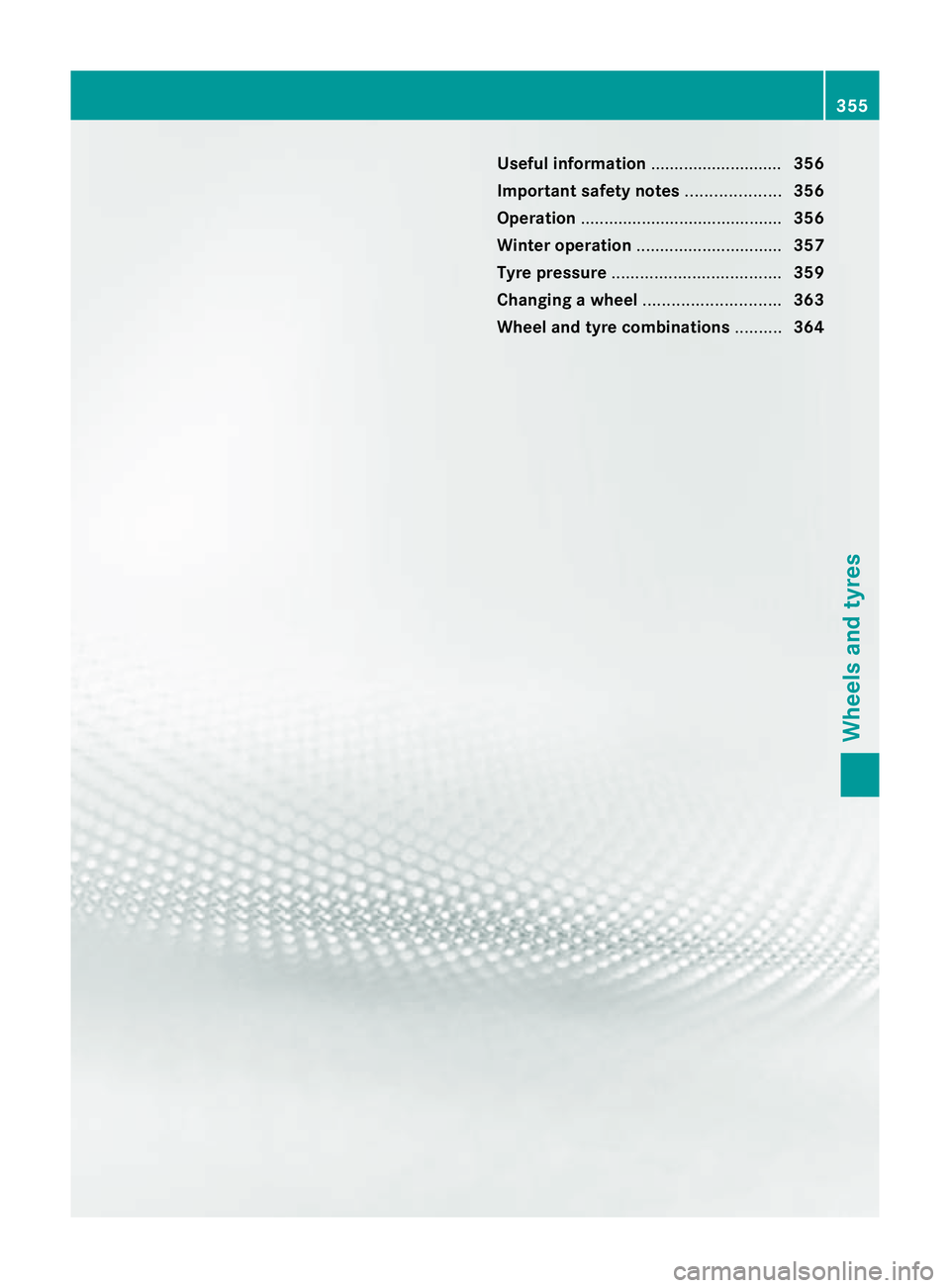
Usefu
linfor mation ............................ 356
Important safet ynotes .................... 356
Operation ........................................... 356
Winter oper ation ............................... 357
Ty re pressure .................................... 359
Changing awheel ............................. 363
Wheel and ty recombinations ..........364 355Wheels and
tyres
Page 359 of 389
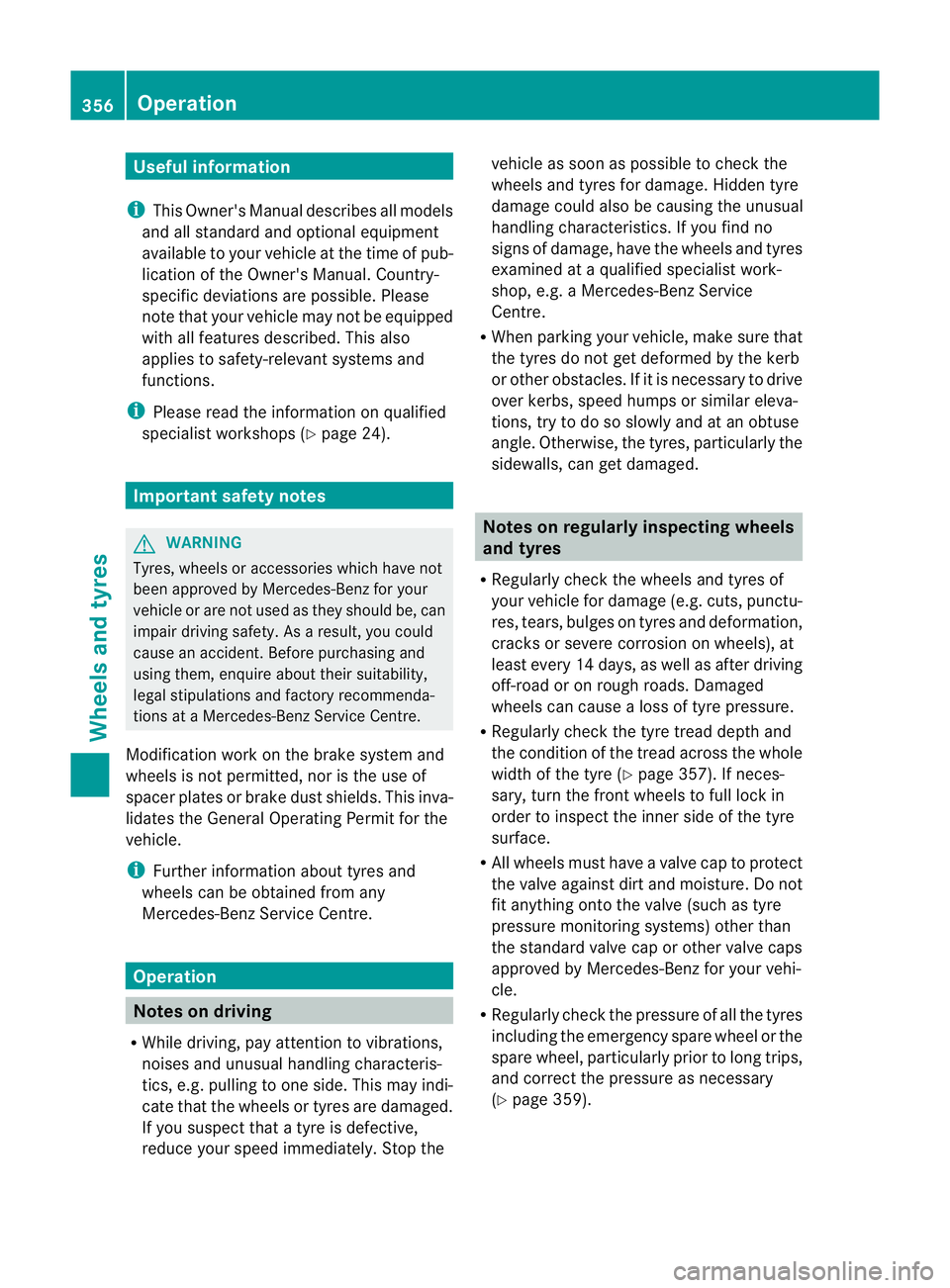
Usefu
linfor mati on
i This Owner's Manual describes all models
and all standard and optional equipment
available to your vehicle at the time of pub-
lication of the Owner's Manual. Country-
specific deviation sare possible .Please
not ethat your vehicle ma ynot be equipped
with all featur es described. This also
applies to safety-releva ntsystems and
functions.
i Please read the information on qualified
specialist workshops (Y page 24).Important safet
ynotes G
WARNING
Tyres, wheels or accessories whic hhaven ot
been approved by Mercedes- Benz foryour
vehicle or are not used as they should be, can
impair driving safety. As aresult, you could
cause an accident .Befor epurchasing and
using them, enquire about their suitability,
legal stipulations and factory recommenda-
tions at aMercedes-Benz Ser vice Centre.
Modificatio nwork on the brake system and
wheels is not permitted, nor is the use of
spacer plate sorbrake dust shields. This inva-
lidates th eGeneral Operatin gPermit for the
vehicle.
i Further information about tyres and
wheels can be obtained from any
Mercedes-Benz Ser vice Centre. Oper
ation Notes on driving
R While driving, pay attention to vibrations,
noises and unusual handling characteris-
tics ,e.g. pulling to one side. This may indi-
cate that the wheels or tyres are damaged.
If you suspect that atyre is defective,
reduce your speed immediately. Stop the vehicle as soo
naspossible to chec kthe
wheels and tyres for damage. Hidden tyre
damage could also be causing the unusual
handling characteristics. If you fin dno
signs of damage, hav ethe wheels and tyres
examined at aqualified specialist work-
shop, e.g. aMercedes-Ben zService
Cent re.
R When parkin gyour vehicle, make sure that
the tyres do not get deformed by the kerb
or other obstacles. If it is necessary to drive
over kerbs, speed humps or similar eleva-
tions, tr ytodosos lowly and at an obtuse
angle. Otherwise, the tyres, particularly the
sidewalls, can get damaged. Notes on regularly inspecting wheels
and tyres
R Regularly chec kthe wheels and tyres of
your vehicle for damage (e.g. cuts, punctu-
res, tears, bulges on tyres and deformation,
crack sorseverecorrosion on wheels), at
least ever y14d ays, as well as after driving
off-road or on rough roads. Damaged
wheels can cause aloss of tyr epressure.
R Regu larly check th etyre tread depth and
the conditio nofthe tread across the whole
widt hofthe tyr e(Ypage 357). If neces-
sary, tur nthe front wheels to full lock in
orde rtoi nspect the inner sid eofthe tyre
surface.
R All wheels must hav eavalve cap to protect
the valve against dirt and moisture. Do not
fit anything onto the valve (such as tyre
pressure monitorin gsystems) othe rthan
the standar dvalve cap or other valve caps
approved by Mercedes-Ben zfor your vehi-
cle.
R Regularly chec kthe pressur eofall the tyres
including the emergenc yspare wheel or the
spare wheel, particularly prior to long trips,
and correc tthe pressur easnecessary
(Y page 359). 356
OperationWheels and tyres
Page 360 of 389
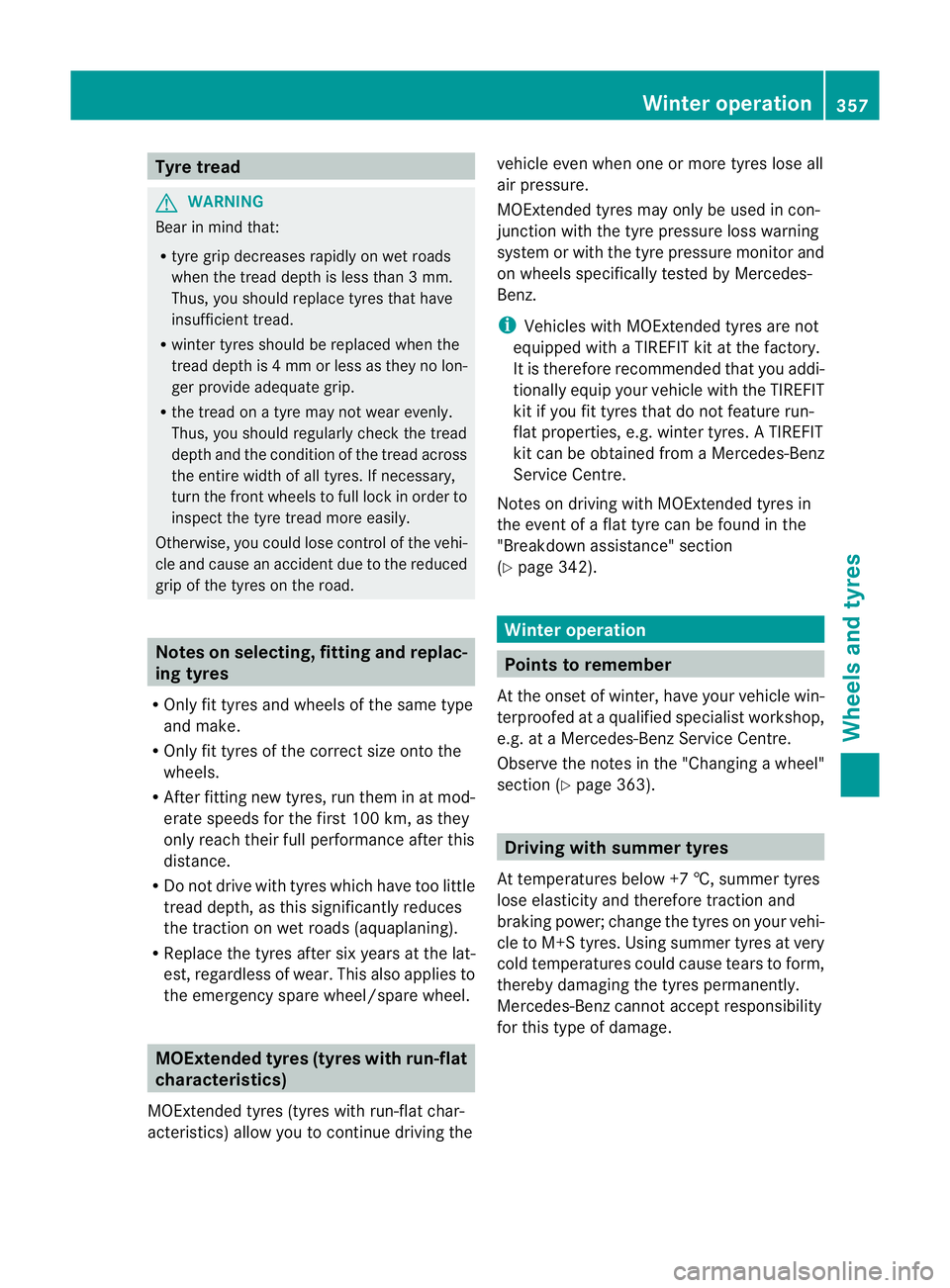
Tyre tread
G
WARNING
Bea rinm ind that:
R tyre gri pdecrease srapidly on wetroads
when the tread depth is less than 3mm.
Thus ,you should repl acet yres that have
insufficient tread.
R winter tyres sho uld bereplaced when the
trea ddepth is 4mmorl ess as they no lon-
ger provide adequat egrip.
R thet rea donat yre may not wear evenly.
Thus ,you should regularly chec kthe tread
depth and the condition of the tread across
the entire widt hofall tyres. If necessary,
turn the fron twheels to full lock in order to
inspec tthe tyr etrea dm ore easily.
Otherwise, you coul dlose control of the vehi-
cle and cause an accident due to the reduced
grip of the tyres on the road. Note
sons electing, fitting and replac-
ing tyres
R Only fit tyres and wheels of the same type
and make.
R Only fit tyres of the correct size onto the
wheels.
R After fittin gnew tyres, run them in at mod-
erat espeeds for the first 10 0km, as they
onl yreach their ful lperformanc eafter this
distance.
R Do not drive wit htyres which have too little
tread depth ,asthis significantly reduces
the traction on wet roads (aquaplaning).
R Replace the tyres after six year satthe lat-
est, regardless of wear .This also applies to
the emergency spar ewheel/spar ewheel. MOExtended ty
res( tyres with run-flat
characteristics)
MOExtended tyres (tyres with run-flat char-
acteristics) allo wyou to continue drivin gthe vehicle even when one or mor
etyres los eall
air pressure.
MOExtended tyres may only be used in con-
junction with the tyre pressure loss warning
system or with the tyre pressure monitor and
on wheels specifically tested by Mercedes-
Benz.
i Vehicles with MOExtended tyres are not
equipped with aTIREFIT kit at th efactory.
It is therefore recommended that you addi-
tionally equip your vehicle with the TIREFIT
kit if you fit tyres that do not feature run-
flat properties, e.g. winter tyres. ATIREFIT
kit can be obtaine dfrom aMercedes-Benz
Ser vice Centre.
Notes on driving with MOExtended tyres in
the event of aflat tyre can be found in the
"Breakdown assistance" section
(Y page 342). Winter operation
Points to remember
At the onset of winter ,have your vehicle win-
terproofed at aqualified specialist workshop,
e.g. at aMercedes-Ben zService Cent re.
Observe the notes in the "Changin gawheel"
section (Y page 363). Drivin
gwith summer ty res
At temperatures below +7 †, summer tyres
los ee lasticit yand therefore traction and
braking power; chang ethe tyres on your vehi-
cle to M+S tyres .Using summer tyres at very
cold temperatures could cause tears to form,
thereby damagin gthe tyres permanently.
Mercedes-Ben zcannot accept responsibility
for this type of damage. Winter operation
357Wheels andtyres Z
Page 361 of 389
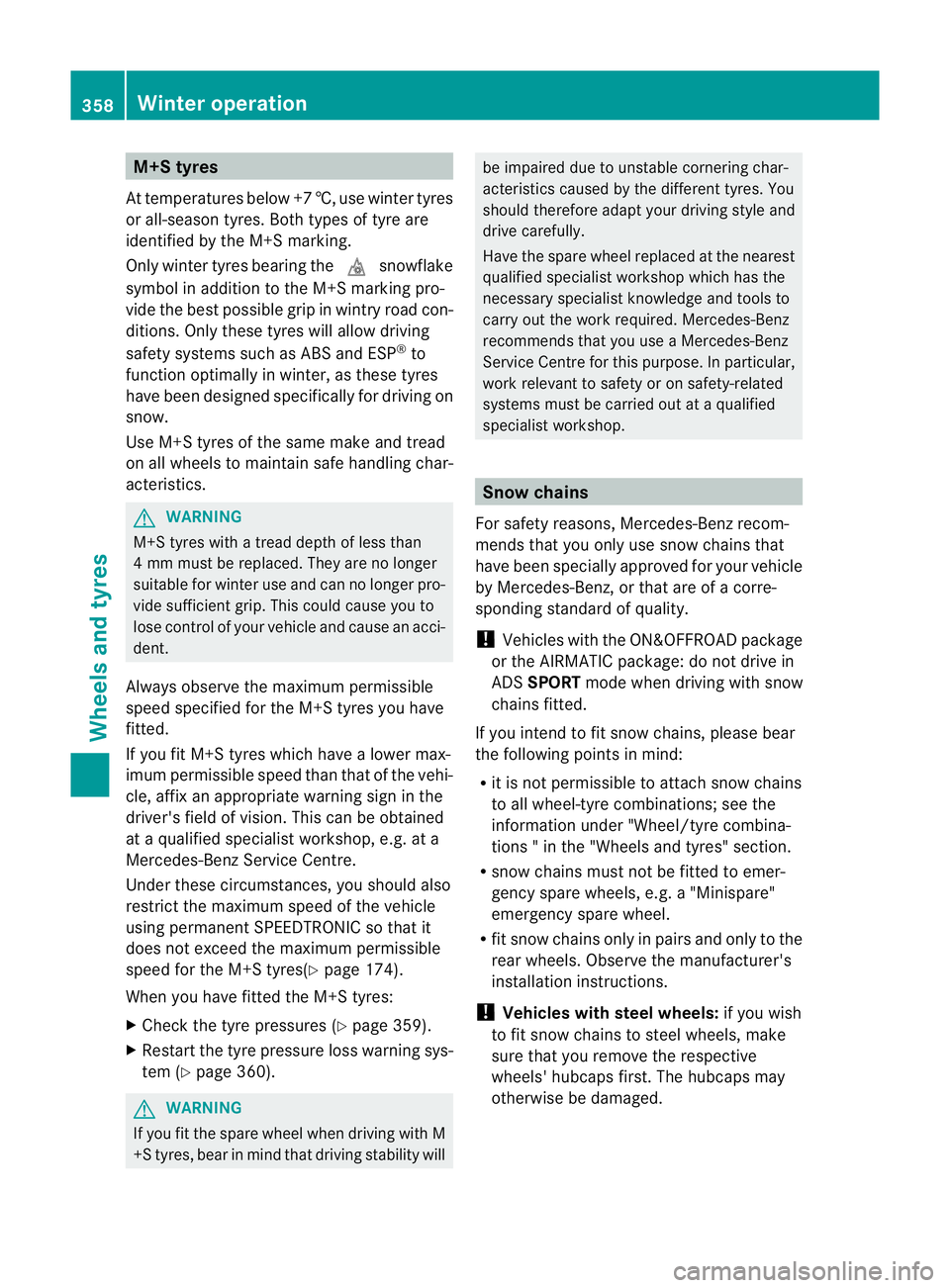
M+S tyres
At temperature sbelo w+ 7† ,use winter tyres
or all-season tyres .Both types of tyr eare
identified by th eM+S marking.
Onl ywinter tyres bearing the isnowflake
symbol in addition to the M+S marking pro-
vide the best possible grip in wintr yroad con-
ditions. Only these tyres will allow driving
safet ysystems such as ABS and ESP ®
to
function optimally in winter, as thes etyres
have been designed specifically for driving on
snow.
Use M+S tyres of the same make and tread
on all wheels to maintain safe handling char-
acteristics. G
WARNING
M+S tyres with atrea ddepth of less than
4mmm ust be replaced. They are no longer
suitable for winter use and can no longer pro-
vide sufficien tgrip. This could cause you to
lose control of your vehicle and cause an acci-
dent.
Always observe the maximum permissible
speed specified for the M+S tyres you have
fitted.
If you fit M+S tyres which have alower max-
imu mpermissible speed than that of the vehi-
cle, affix an appropriate warning sign in the
driver' sfield of vision. This can be obtained
at aq ualified specialist workshop, e.g. at a
Mercedes-Ben zService Centre.
Under these circumstances, you should also
restrict the maximu mspeed of the vehicle
using permanent SPEEDTRONIC so that it
does not exceed the maximum permissible
speed for the M+S tyres(Y page 174).
When you have fitted the M+S tyres:
X Check the tyr epressures (Y page 359).
X Restart th etyre pressure los swarning sys-
tem (Y page 360). G
WARNING
If you fit the spare wheel when driving with M
+S tyres, bear in mind that driving stability will be impaired due to unstable cornerin
gchar-
acteristic scaused by the different tyres. You
shoul dtherefore adapt your drivin gstyle and
drive carefully.
Have the spare whee lreplaced at the nearest
qualified specialist workshop which has the
necessar yspecialist knowledge and tools to
carry out the work required. Mercedes-Benz
recommends that you use aMercedes-Benz
Ser vice Centre for thi spurpose. In particular,
work relevant to safety or on safety-related
systems must be carried out at aqualified
specialist workshop. Snow chains
For safety reasons ,Mercedes-Benz recom-
mends that you only use snow chain sthat
hav ebeen specially approved for your vehicle
by Mercedes-Benz ,orthat ar eofac orre-
spondin gstandard of quality.
! Vehicle swith the ON&OFFROAD package
or the AIRMATIC package: do not drive in
ADS SPORT mode when drivin gwith snow
chains fitted.
If you intend to fit snow chains, please bear
the following point sinmind:
R it is not permissible to attac hsnow chains
to all wheel-tyre combinations ;see the
information under "Wheel/tyre combina-
tion s"int he "Wheels and tyres" section.
R snow chains must not be fit tedtoe mer-
gency spare wheels ,e.g. a"Minispare"
emergency spar ewheel.
R fit snow chains only in pair sand only to the
rear wheels .Observ ethe manufacturer's
installation instructions.
! Vehicle swith steel wheels: if you wish
to fit snow chains to steel wheels, make
sure that you remove the respective
wheels' hubcaps first .The hubcaps may
otherwise be damaged. 358
Winter operationWheels and tyres
Page 362 of 389
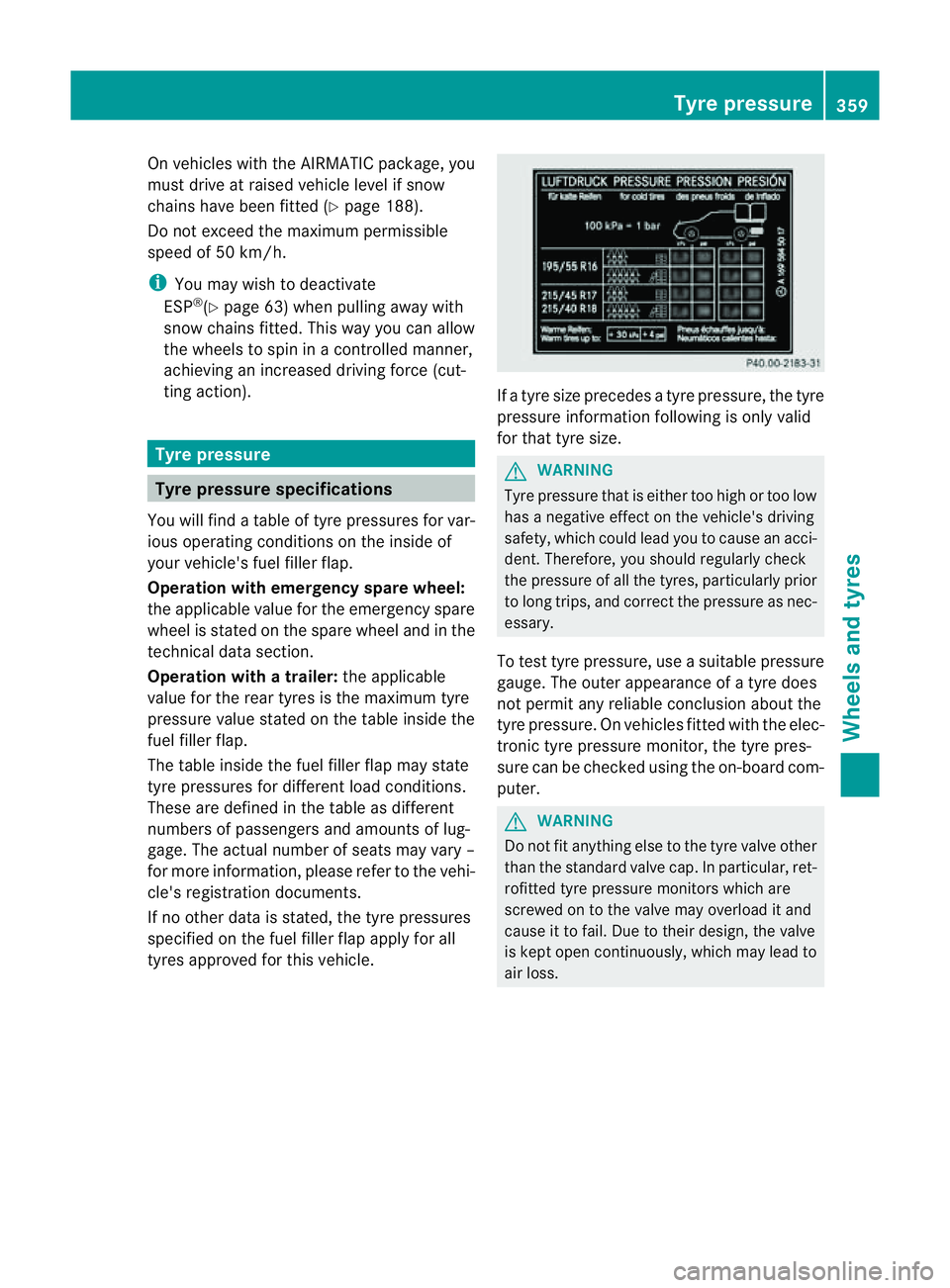
On vehicle
swith the AIRMATIC package, you
must drive at raised vehicle level if snow
chains have been fitted (Y page 188).
Do not exceed the maximum permissible
speed of 50 km/h.
i You may wish to deactivate
ESP ®
(Y page 63) when pulling away with
snow chains fitted. This way you can allow
the wheels to spin in acontrolled manner,
achievin ganincrease ddriving force (cut-
tin ga ction). Tyre pressure
Tyre pressure specifications
You wil lfind atable of tyre pressures for var-
ious operating conditions on the inside of
your vehicle's fuel filler flap.
Operation with emergency spare wheel:
the applicable value for the emergency spare
wheel is stated on the spare wheel and in the
technical data section.
Operation with atrailer: the applicable
value for the rear tyres is the maximum tyre
pressure value stated on the table insid ethe
fuel filler flap.
The tabl einsid ethe fuel filler fla pmay state
tyre pressures for different load conditions.
Thes eare define dinthe tabl easdifferent
number sofpassengers and amounts of lug-
gage. The actual number of seats may vary –
for more information, please refer to the vehi-
cle's registration documents.
If no other data is stated, the tyre pressures
specified on the fuel filler flap appl yfor all
tyres approved for this vehicle. If
at yre size precede satyre pressure, the tyre
pressure information following is only valid
for that tyre size. G
WARNING
Tyre pressure that is eithe rtoo high or too low
has anegativ eeffect on the vehicle's driving
safety ,which coul dlead you to cause an acci-
dent. Therefore, you should regularly check
the pressur eofall the tyres, particularly prior
to long trips, and correct the pressure as nec-
essary.
To test tyre pressure, use asuitabl epressure
gaug e. Th eouter appearance of atyre does
not permit any reliabl econclusion about the
tyr ep ressure. On vehicles fitted wit hthe elec-
tronic tyr epressure monitor, th etyre pres-
sure can be checked using the on-board com-
puter. G
WARNING
Do not fit anything else to the tyre valve other
than the standard valve cap. In particular, ret-
rofitted tyre pressure monitors which are
screwed on to the valve may overload it and
cause it to fail. Due to their design, the valve
is kept open continuousl y, whichmay lead to
air loss. Tyr
epressure
359Wheels and tyres Z
Page 363 of 389
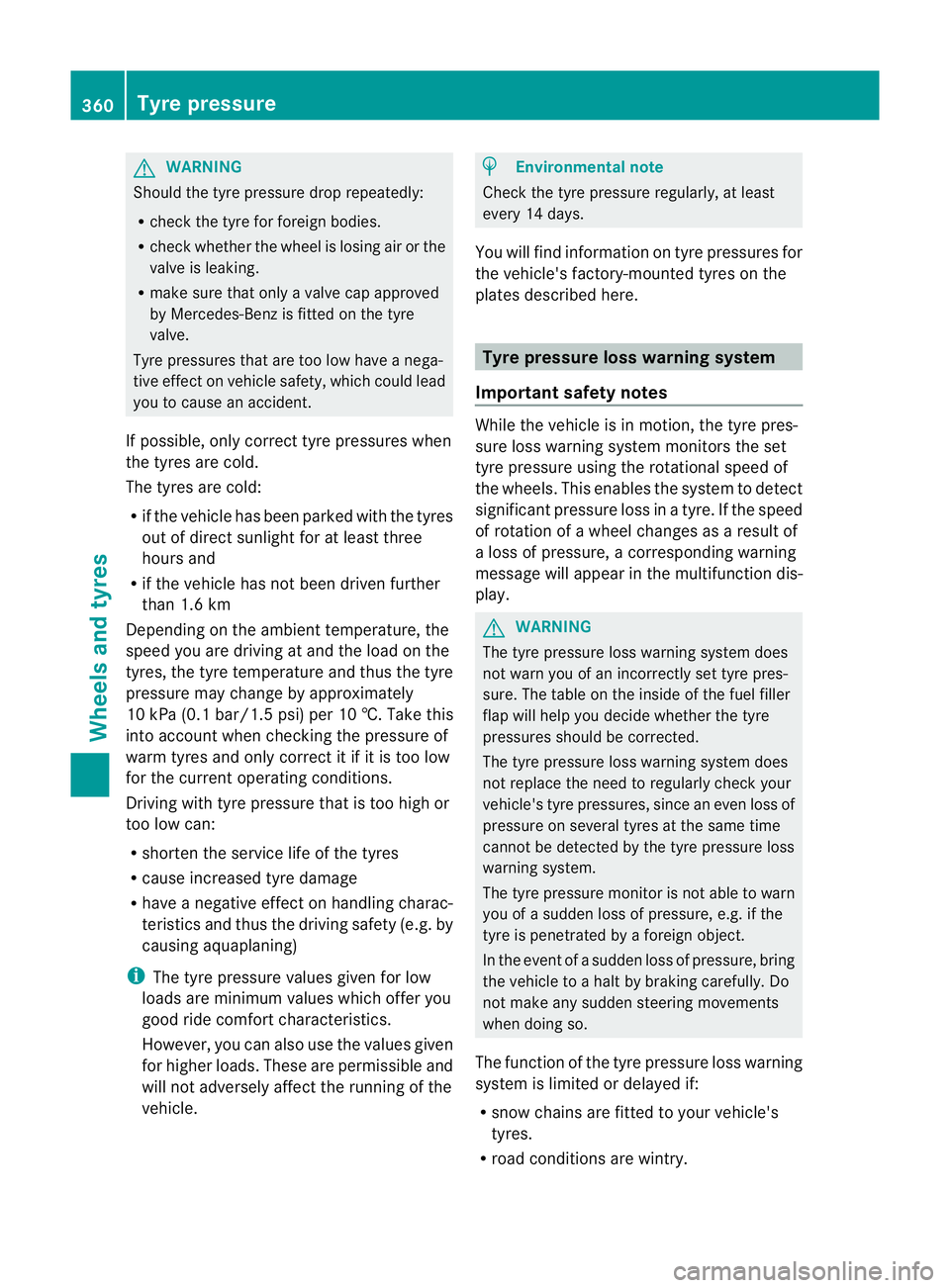
G
WARNING
Shoul dthe tyr epressure dro prepeatedly:
R check the tyr efor foreign bodies.
R check whether the wheel is losing air or the
valve is leaking.
R make sure that only avalve cap approved
by Mercedes-Benz is fitted on the tyre
valve.
Tyre pressures that are too low have anega-
tiv ee ffect on vehicl esafety, which could lead
you to cause an accident.
If possible, only correc ttyre pressures when
the tyres are cold.
The tyres are cold:
R if the vehicl ehas been parked wit hthe tyres
out of direc tsunlight for at least three
hours and
R if the vehicle has not been driven further
than 1. 6km
Depe nding on the ambient temperature, the
speed you are drivin gatand the load on the
tyres, the tyre temperature and thus the tyre
pressure may chang ebyapproximately
10 kPa (0. 1bar/1 .5psi) per 10 †. Take this
int oa ccount whe nchecking the pressur eof
warm tyres and only correc titifitist oo low
for the curren toperating conditions.
Drivin gwith tyre pressure that is too high or
too low can:
R shorten the servic elife of the tyres
R cause increased tyre damage
R have anegativ eeffect on handling charac-
teristics and thus th edriving safet y(e.g. by
causin gaquaplaning)
i The tyr epressure values given for low
load sare minimum values which offe ryou
good rid ecomfort characteristics.
However, you can also use the values given
for higher loads. These ar epermissible and
will not adversely affect the running of the
vehicle. H
Environmenta
lnote
Check the tyre pressure regularly, at least
every 14 days.
You will find information on tyre pressures for
the vehicle's factory-mounted tyres on the
plates described here. Tyr
epressure loss warning system
Important safety notes Whil
ethe vehicle is in motion, the tyr epres-
sure loss warning system monitors th eset
tyr ep ressure using th erotational speed of
the wheels. This enables the system to detect
significant pressure loss in atyre. If the speed
of rotation of awheel changes as aresult of
al oss of pressure, acorrespondin gwarning
message will appea rinthe multifunction dis-
play. G
WARNING
The tyr epressure loss warning system does
not warn you of an incorrectly se ttyre pres-
sure. The table on the insid eofthe fuel filler
fla pw ill help you decide whether the tyre
pressures should be corrected.
The tyre pressure loss warnin gsystem does
not replace the need to regularly check your
vehicle's tyre pressures, since an even loss of
pressure on several tyres at the same time
cannot be detecte dbythe tyr epressure loss
warning system.
Th et yre pressure monitor is not able to warn
you of asudden loss of pressure, e.g. if the
tyre is penetrated by aforeign objec t.
In the event of asudden loss of pressure, bring
the vehicle to ahalt by braking carefully. Do
not make any sudden steering movements
when doing so.
The function of the tyre pressure loss warning
system is limited or delayed if:
R snow chains are fitted to your vehicle's
tyres.
R road conditions are wintry. 360
Tyr
epressureWheels and tyres
Page 364 of 389
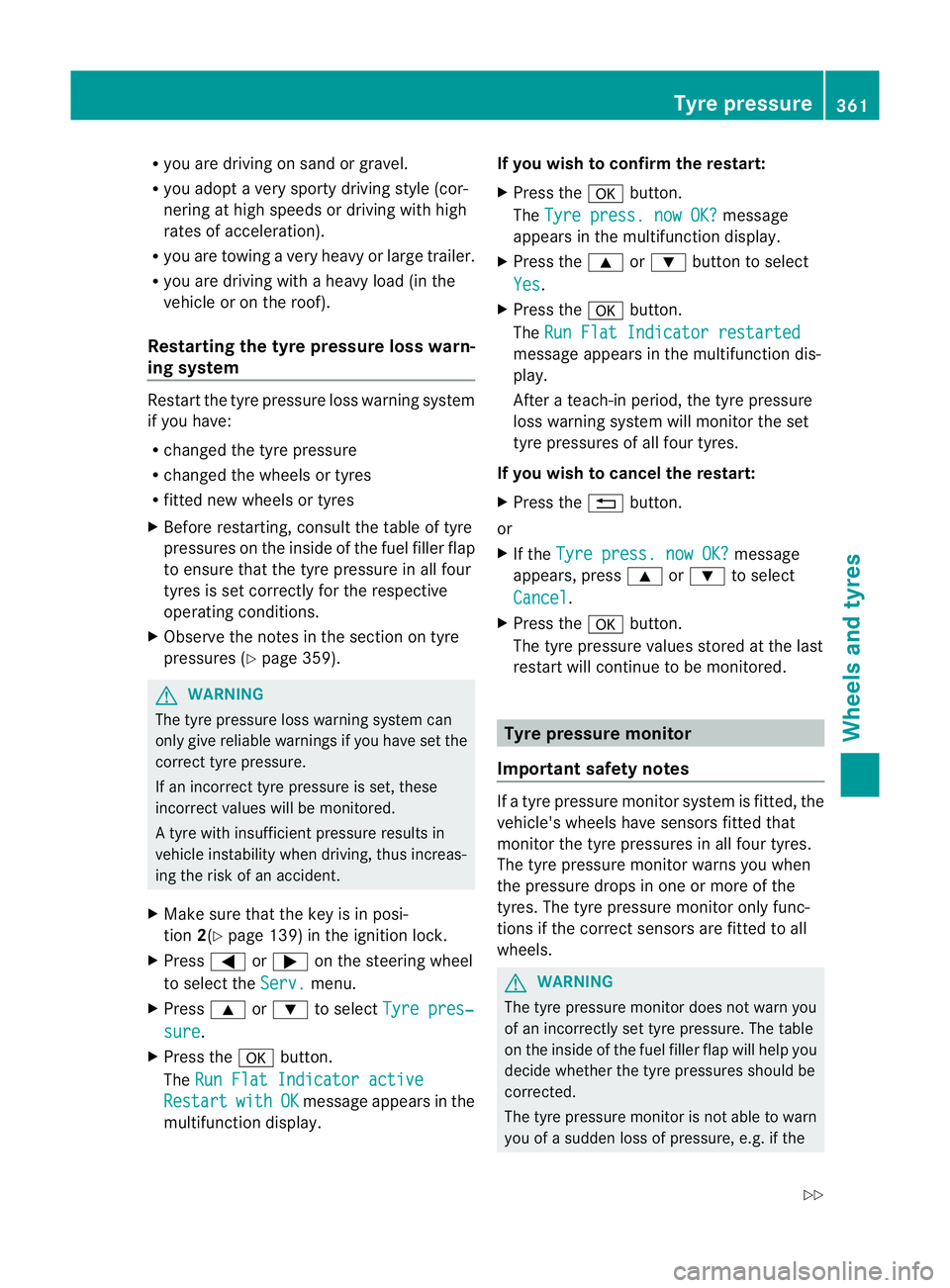
R
you are drivin gonsandorg ravel.
R yo ua dopt averys porty driv ings tyle (cor-
nering at hig hspeeds or driv ingw ith high
rates of acceleration).
R you are towing avery heavy or lar getrailer.
R you are driving with aheavy load (in the
vehic le oron the roof).
Restarting th etyre pressure lo sswarn-
ing system Restart the tyre press
urel oss warnin gsystem
if you have:
R changed the tyre press ure
R changed the whe elso rtyres
R fitted new wheels or tyres
X Before restarting, consult the table of tyre
press ures on the inside of the fuel filler flap
to ensur ethat the tyr epressure in all four
tyre siss et correctly for the respective
operating conditions.
X Observ ethe notes in the section on tyre
pressures (Y page 359). G
WARNING
The tyr epressure loss warn ings ystem can
only give reliabl ewarnings if you have set the
correct tyre pressure.
If an incorrect tyre pressure is set, these
incorrect values wil lbemonitored.
At yre with insufficient pressure results in
vehicle instability when driving, thu sincreas-
ing the risk of an accident.
X Make sure that the key is in pos i-
tion 2(Ypage139) in the igniti onlock.
X Press =or; on the steering wheel
to select the Serv. menu.
X Press 9or: to select Tyre pres‐ sure .
X Press the abutton.
The RunF lat Indicato ractive Restart with OK message ap
pears in the
multifunction display. If you wis
htoconfirm the restart:
X Press the abutton.
The Tyre press. no wOK? message
ap pe ars in the multifunction display.
X Press the 9or: button to select
Yes .
X Press the abutton.
The RunF lat Indicato rrestarted message ap
pears in the multifunction dis-
play.
After ateach-in period, the tyr epressure
loss warn ings ystem wil lmonitor the set
tyr ep ressures of all fou rtyres.
If you wis htocancel the restart:
X Press the %button.
or
X If the Tyre press. now OK? message
appears ,press 9 or: to select
Cancel .
X Press the abutton.
Th et yre press urev alues stored at the last
restart wil lcontinue to be monitored. Tyre pressur
emonitor
Important safety notes If
at yre press urem onitor system is fitted, the
vehicle's wheels have sensor sfitted that
monitor the tyre pressures in all four tyres.
The tyre pressure monitor warns you when
the pressure drops in one or more of the
tyres. The tyre pressure monitor only func-
tions if the correct sensors are fitted to all
wheels. G
WARNING
The tyre pressure monitor does not warn you
of an incorrectly set tyre pressure. The table
on the inside of the fuel filler flap wil lhelp you
decide whether the tyre pressures should be
correc ted.
The tyr epressure monitor is not abl etow arn
you of asudden loss of pressure, e.g. if the Tyr
epressure
361Wheels and tyres
Z